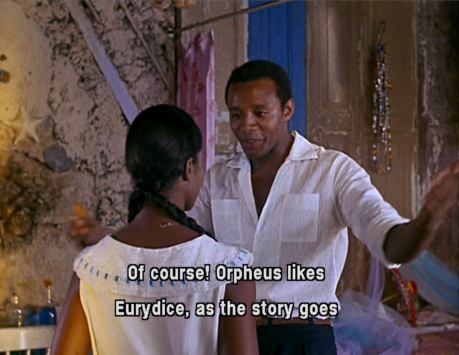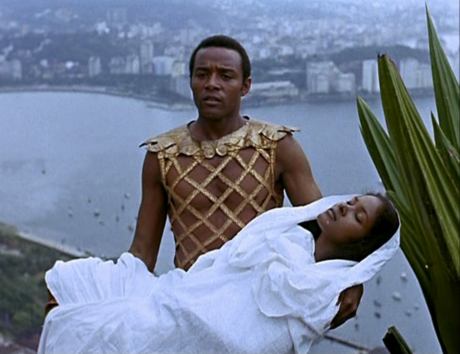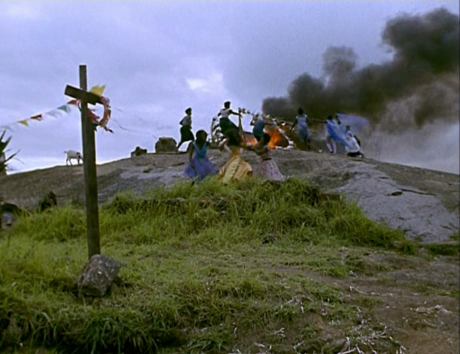 Before I describe it any further, let's review the story of Orpheus, as outlined by Robert Graves in The Greek Myths (the sourcebook for Xena and Hercules). Orpheus was the greatest musician and poet who ever lived. He was born a prince in Thrace, and his mother was the Muse Calliope. He was taught to play the lyre by Apollo, and could even make the trees dance. He sailed with Jason and the Argonauts, then came back to Thrace, and married Eurydice. She was assaulted by Aristaeus, and died as a result. Orpheus descended into Tartarus, using his lyre to charm Charon and Cerberus, and even Hades himself, convincing him to allow Eurydice to return, on condition Orpheus led the way and never looked back. At the last moment, he couldn't resist, and lost Eurydice forever. Orpheus became a priest of Apollo, instructing the Thracians that human sacrifice was wrong. When Dionysus arrived in his land, Orpheus resisted him, as Penthius would later in The Bacchae. He preached against the maenadism inspired by Dionysus, and as a result, the maenads became enraged, murdering their husbands, storming the temple of Apollo and seizing Orpheus. They tore him limb from limb and scattered his body parts. The Muses, led by his mother, Calliope, collected and buried them at the foot of Mt. Olympus. His head was unrecovered, however; it floated down river and ended up in a cave, where it became an oracle that overshadowed Apollo's own temple at Delphi. His lyre floated all the across the sea to the island of Lesbos, where it was discovered by the Muses and changed into a constellation. According to Graves, this myth disguises a much older religious tradition, in which Orpheus was a symbol for the sacrificial king in a matriarchal ritual. His worship of Apollo and denunciation of the maenads was actually a later, patriarchal rewrite: he was in fact a preacher of Dionysus, and helped found his Mysteries in Greece. His decapitation and silencing by Apollo was metaphorical, and his descent into Tartarus to rescue his wife was a misinterpretation by patriarchal Greeks of ancient temple paintings: they were actually depicting Dionysus's descent to rescue his mother, Semele. In other words, Graves is suggesting that the myth of Orpheus itself is just a later incarnation of an even older tale. Black Orpheus takes it in the other direction, translating the elements of the Orpheus story into modern-day Brazil, and it's easy to see how it inspired the sights and sounds of Hercules and Xena. The hypnotic samba beat heard throughout much of the film was borrowed by composer Joe LoDuca and can be found as background music during the shows' Dionysiac moments. It contributed its vision of a multicultural cast along with its playful recasting of mythical archetypes into familiar urban characters. The film is one of the spiritual forefathers of the "Xena Scrolls" concept, and even the concept of the "ubers", those episodes set in the present day. Last but not least, the depiction of the two main characters as eternal soulmates who recognize each other in their different incarnations must certainly find roots here, and given that it was a part of the DNA of "Rob's Vision", it was only a matter of time before it manifested itself in the story of the orphic hero, Xena. The film depicts Eurydice as an innocent woman from the provinces, arriving by boat to Rio on the eve of Carnaval. The entire city seems to move to a single beat as it prepares for the festival, which is like Mardi Gras on a grander scale, the last celebration before the Lent season, the 40 day period of self-denial ending on Easter, the day of Christ's resurrection. She sees all sorts of strange sights as she makes her way through the streets: people in all kinds of costumes from all periods of history, musicians with their groaning instruments, flirty shopkeepers selling octopus and offering her fish: "No one can resist the madness," she's told. She's visiting her cousin, Serafina, but she has a dark secret: she's been followed by a man in black costume and head mask, a figure of Death who wants to kill her. The driver of the trolley she boards is a young man named Orpheus, a musician who can "make the sun rise" with his music. He's a cheerful fellow who's instantly drawn towards her. He's about to get married to someone else, however, a flighty woman who's friends with Serafina. Orpheus takes his fiance to a magistrate, who jokes about his name: everyone knows Orpheus is destined to love Eurydice, so where is she? Back at the train station, a conductor named Hermes points Eurydice in the direction of Serafina's house, where she hopes to elude this mysterious deathly figure. Not far away, Orpheus plays his guitar for the local children. It's inscribed "Orpheus is my master", signifying that its present owner is only one of many Orpheus's who will play it; for the moment, it will only play for him. He strums a tune, and charms Eurydice, who happens to be nearby. At that moment, they both realize they're meant for each other, and Orpheus wonders how he'll get out of his obligation to his fiance. To make matters worse, the man dressed as Death finds them in their hilltop village, and tries to kidnap Eurydice, but Orpheus fends him off. They decide upon a ruse for the Carnaval: Eurydice will dress in Serafina's costume, but her disguise doesn't work for long. Orpheus's fiance discovers the deception, and Death, his unusual appearance blending in perfectly with the city's costumed dancers, chases Eurydice into the train station. She's electrocuted when Orpheus unknowingly turns on the power as she's grasping the electric wires. Death's work is done, but Orpheus won't let her go. He's not sure where to look, but he'll search everywhere. He makes his way past rioting female soccer fans (the modern version of maenads!) being loaded into a police van, and arrives at the Missing Persons bureau, but there he finds only a soulless bureaucracy. A janitor points him towards a local Umbanda church, where the shaman-like priest has powers to bring back the dead. Orpheus attends the ritual surrounded by women in the throes of religious ecstasy. He calls her name, and from one of them he hears Eurydice's voice calling to him. Like his mythical counterpart, he must be content with only her voice, but unable to resist, he looks towards the worshipper channelling her, dispelling the magic forever.   Not all writers use this technique, though; some don't need to, some find it constricting or artificial, while others find it liberating. Judging from the interviews I've read and looking at the results, I'd say Rob Tapert and Sam Raimi derived a lot of creative freedom from the conscious and deliberate use of templates, and still do, even to this day. Rob's quote earlier about there being no logic to how death is used on the show most likely refers to its internal structure (its "plot,", in other words) which is what his staff would've focused on, but we'll see how sources like Black Orpheus help him provide an external logic (that is, "template") for the overall theme of death and rebirth. It shouldn't surprise us that the team that placed a higher priority on incorporating references rather than story logic in movies like Army of Darkness would continue that process in their tv shows. |
The Types and Patterns of All Things Xena > Free To Be Euripides: Chapter Index
Back to Home menu